Clinton Doughnuts: Report on Market Analysis and Innovation Strategies
VerifiedAdded on 2022/09/05
|12
|2869
|15
Report
AI Summary
This report presents a comprehensive analysis of Clinton Doughnuts, examining its current business market and identifying major competitors like Krispy Kreme and Donut King. It explores franchise models, delivery strategies, and potential customer segments. The report further investigates innovative business strategies, including targeted marketing and social media advertisement, with a cost-benefit analysis of current contracts. A risk assessment is conducted, identifying potential challenges like lack of resources and customer demand, and proposing contingency plans. The report also includes an implementation plan, outlining actions, objectives, and monitoring procedures for the proposed strategies. The assessment uses case studies and roleplay to identify and implement business innovation.
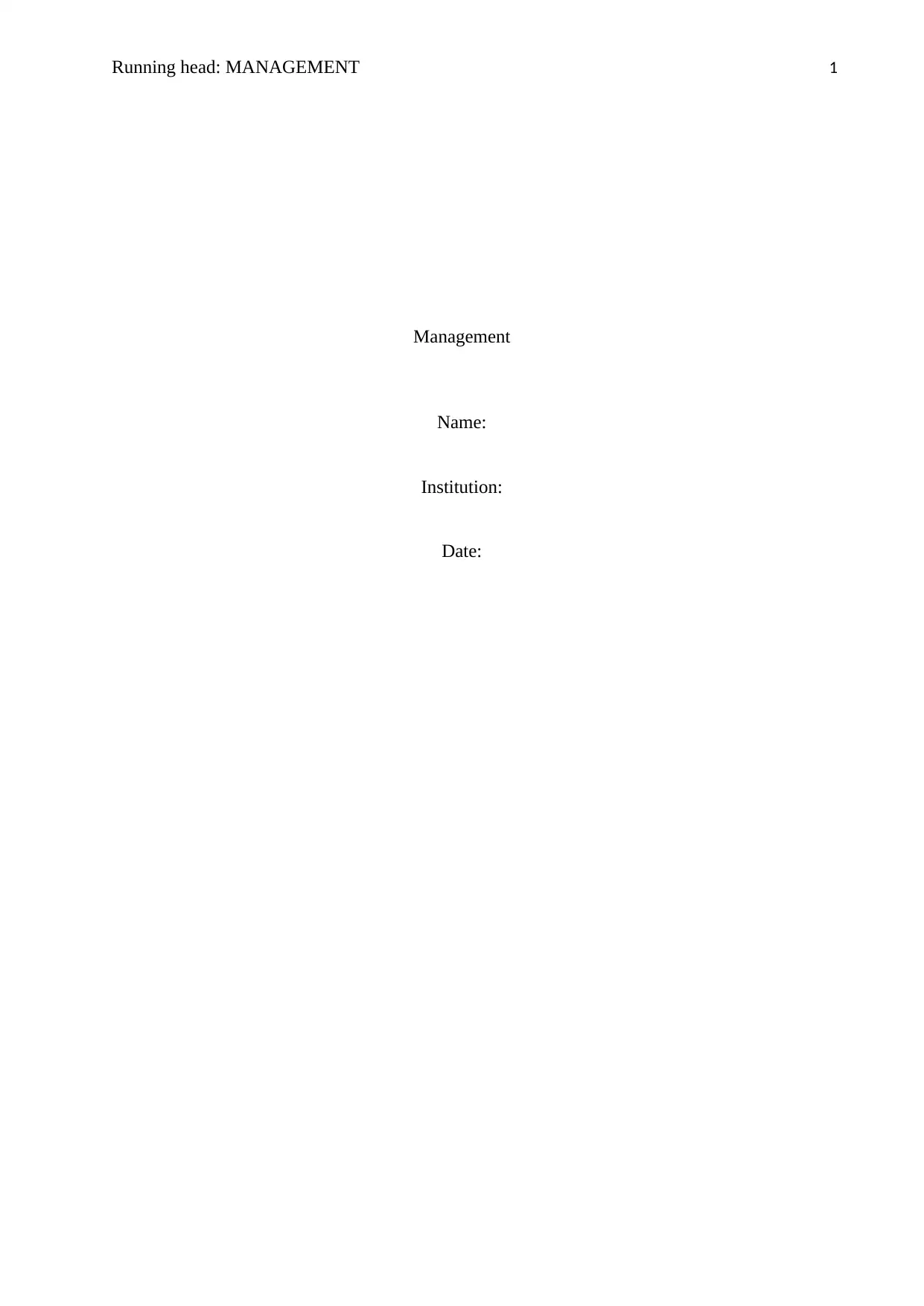
Running head: MANAGEMENT 1
Management
Name:
Institution:
Date:
Management
Name:
Institution:
Date:
Paraphrase This Document
Need a fresh take? Get an instant paraphrase of this document with our AI Paraphraser
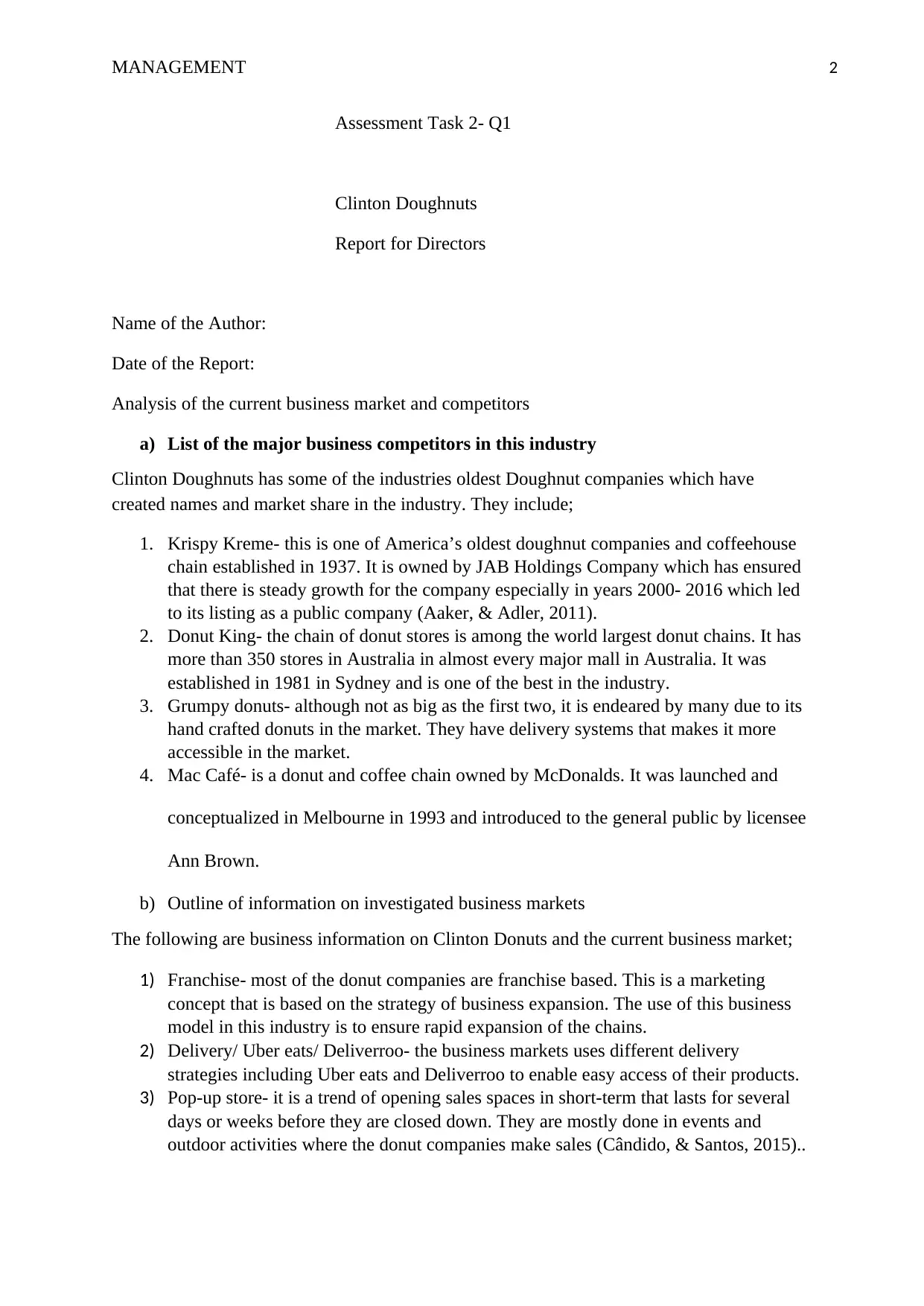
MANAGEMENT 2
Assessment Task 2- Q1
Clinton Doughnuts
Report for Directors
Name of the Author:
Date of the Report:
Analysis of the current business market and competitors
a) List of the major business competitors in this industry
Clinton Doughnuts has some of the industries oldest Doughnut companies which have
created names and market share in the industry. They include;
1. Krispy Kreme- this is one of America’s oldest doughnut companies and coffeehouse
chain established in 1937. It is owned by JAB Holdings Company which has ensured
that there is steady growth for the company especially in years 2000- 2016 which led
to its listing as a public company (Aaker, & Adler, 2011).
2. Donut King- the chain of donut stores is among the world largest donut chains. It has
more than 350 stores in Australia in almost every major mall in Australia. It was
established in 1981 in Sydney and is one of the best in the industry.
3. Grumpy donuts- although not as big as the first two, it is endeared by many due to its
hand crafted donuts in the market. They have delivery systems that makes it more
accessible in the market.
4. Mac Café- is a donut and coffee chain owned by McDonalds. It was launched and
conceptualized in Melbourne in 1993 and introduced to the general public by licensee
Ann Brown.
b) Outline of information on investigated business markets
The following are business information on Clinton Donuts and the current business market;
1) Franchise- most of the donut companies are franchise based. This is a marketing
concept that is based on the strategy of business expansion. The use of this business
model in this industry is to ensure rapid expansion of the chains.
2) Delivery/ Uber eats/ Deliverroo- the business markets uses different delivery
strategies including Uber eats and Deliverroo to enable easy access of their products.
3) Pop-up store- it is a trend of opening sales spaces in short-term that lasts for several
days or weeks before they are closed down. They are mostly done in events and
outdoor activities where the donut companies make sales (Cândido, & Santos, 2015)..
Assessment Task 2- Q1
Clinton Doughnuts
Report for Directors
Name of the Author:
Date of the Report:
Analysis of the current business market and competitors
a) List of the major business competitors in this industry
Clinton Doughnuts has some of the industries oldest Doughnut companies which have
created names and market share in the industry. They include;
1. Krispy Kreme- this is one of America’s oldest doughnut companies and coffeehouse
chain established in 1937. It is owned by JAB Holdings Company which has ensured
that there is steady growth for the company especially in years 2000- 2016 which led
to its listing as a public company (Aaker, & Adler, 2011).
2. Donut King- the chain of donut stores is among the world largest donut chains. It has
more than 350 stores in Australia in almost every major mall in Australia. It was
established in 1981 in Sydney and is one of the best in the industry.
3. Grumpy donuts- although not as big as the first two, it is endeared by many due to its
hand crafted donuts in the market. They have delivery systems that makes it more
accessible in the market.
4. Mac Café- is a donut and coffee chain owned by McDonalds. It was launched and
conceptualized in Melbourne in 1993 and introduced to the general public by licensee
Ann Brown.
b) Outline of information on investigated business markets
The following are business information on Clinton Donuts and the current business market;
1) Franchise- most of the donut companies are franchise based. This is a marketing
concept that is based on the strategy of business expansion. The use of this business
model in this industry is to ensure rapid expansion of the chains.
2) Delivery/ Uber eats/ Deliverroo- the business markets uses different delivery
strategies including Uber eats and Deliverroo to enable easy access of their products.
3) Pop-up store- it is a trend of opening sales spaces in short-term that lasts for several
days or weeks before they are closed down. They are mostly done in events and
outdoor activities where the donut companies make sales (Cândido, & Santos, 2015)..
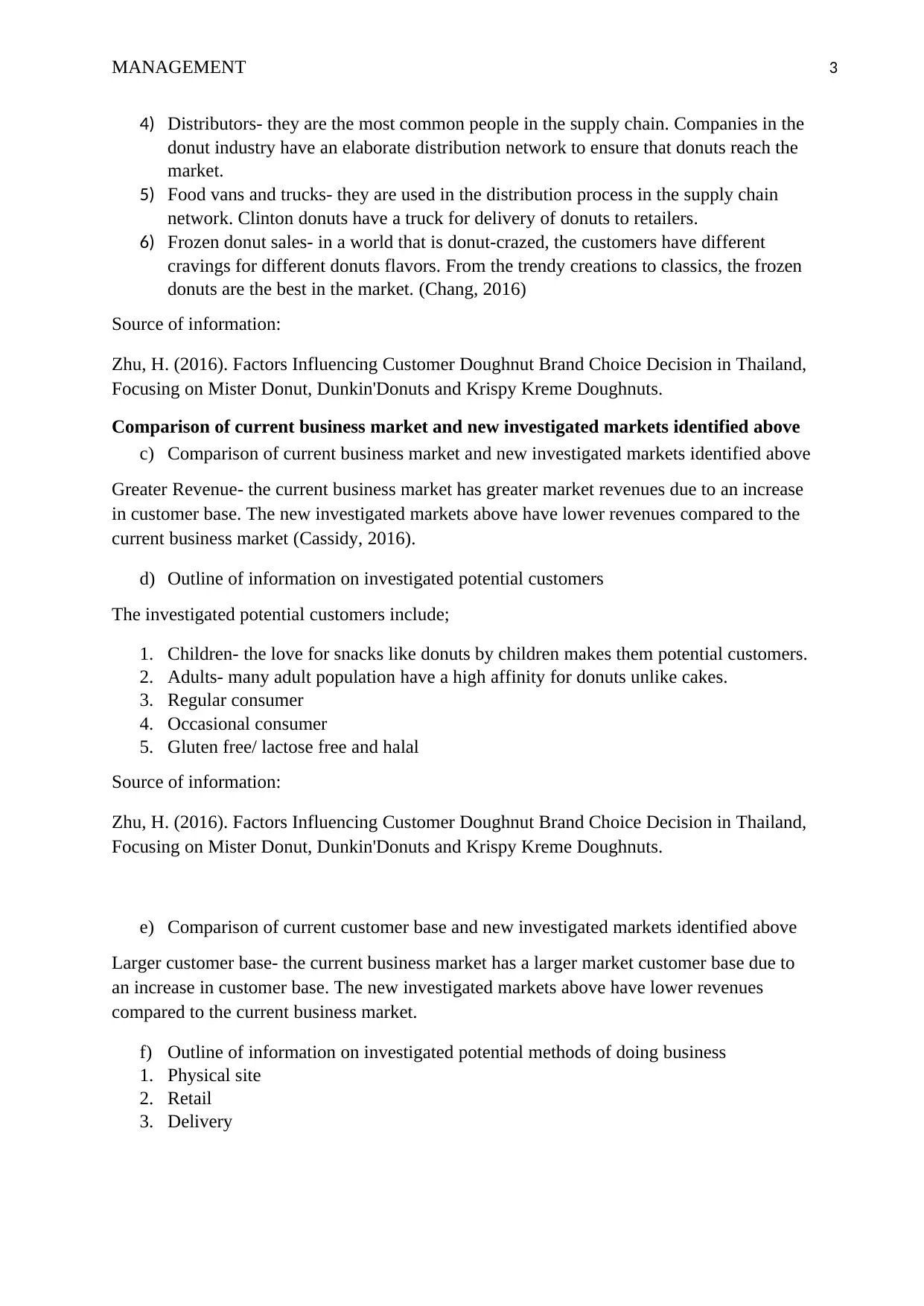
MANAGEMENT 3
4) Distributors- they are the most common people in the supply chain. Companies in the
donut industry have an elaborate distribution network to ensure that donuts reach the
market.
5) Food vans and trucks- they are used in the distribution process in the supply chain
network. Clinton donuts have a truck for delivery of donuts to retailers.
6) Frozen donut sales- in a world that is donut-crazed, the customers have different
cravings for different donuts flavors. From the trendy creations to classics, the frozen
donuts are the best in the market. (Chang, 2016)
Source of information:
Zhu, H. (2016). Factors Influencing Customer Doughnut Brand Choice Decision in Thailand,
Focusing on Mister Donut, Dunkin'Donuts and Krispy Kreme Doughnuts.
Comparison of current business market and new investigated markets identified above
c) Comparison of current business market and new investigated markets identified above
Greater Revenue- the current business market has greater market revenues due to an increase
in customer base. The new investigated markets above have lower revenues compared to the
current business market (Cassidy, 2016).
d) Outline of information on investigated potential customers
The investigated potential customers include;
1. Children- the love for snacks like donuts by children makes them potential customers.
2. Adults- many adult population have a high affinity for donuts unlike cakes.
3. Regular consumer
4. Occasional consumer
5. Gluten free/ lactose free and halal
Source of information:
Zhu, H. (2016). Factors Influencing Customer Doughnut Brand Choice Decision in Thailand,
Focusing on Mister Donut, Dunkin'Donuts and Krispy Kreme Doughnuts.
e) Comparison of current customer base and new investigated markets identified above
Larger customer base- the current business market has a larger market customer base due to
an increase in customer base. The new investigated markets above have lower revenues
compared to the current business market.
f) Outline of information on investigated potential methods of doing business
1. Physical site
2. Retail
3. Delivery
4) Distributors- they are the most common people in the supply chain. Companies in the
donut industry have an elaborate distribution network to ensure that donuts reach the
market.
5) Food vans and trucks- they are used in the distribution process in the supply chain
network. Clinton donuts have a truck for delivery of donuts to retailers.
6) Frozen donut sales- in a world that is donut-crazed, the customers have different
cravings for different donuts flavors. From the trendy creations to classics, the frozen
donuts are the best in the market. (Chang, 2016)
Source of information:
Zhu, H. (2016). Factors Influencing Customer Doughnut Brand Choice Decision in Thailand,
Focusing on Mister Donut, Dunkin'Donuts and Krispy Kreme Doughnuts.
Comparison of current business market and new investigated markets identified above
c) Comparison of current business market and new investigated markets identified above
Greater Revenue- the current business market has greater market revenues due to an increase
in customer base. The new investigated markets above have lower revenues compared to the
current business market (Cassidy, 2016).
d) Outline of information on investigated potential customers
The investigated potential customers include;
1. Children- the love for snacks like donuts by children makes them potential customers.
2. Adults- many adult population have a high affinity for donuts unlike cakes.
3. Regular consumer
4. Occasional consumer
5. Gluten free/ lactose free and halal
Source of information:
Zhu, H. (2016). Factors Influencing Customer Doughnut Brand Choice Decision in Thailand,
Focusing on Mister Donut, Dunkin'Donuts and Krispy Kreme Doughnuts.
e) Comparison of current customer base and new investigated markets identified above
Larger customer base- the current business market has a larger market customer base due to
an increase in customer base. The new investigated markets above have lower revenues
compared to the current business market.
f) Outline of information on investigated potential methods of doing business
1. Physical site
2. Retail
3. Delivery
⊘ This is a preview!⊘
Do you want full access?
Subscribe today to unlock all pages.

Trusted by 1+ million students worldwide
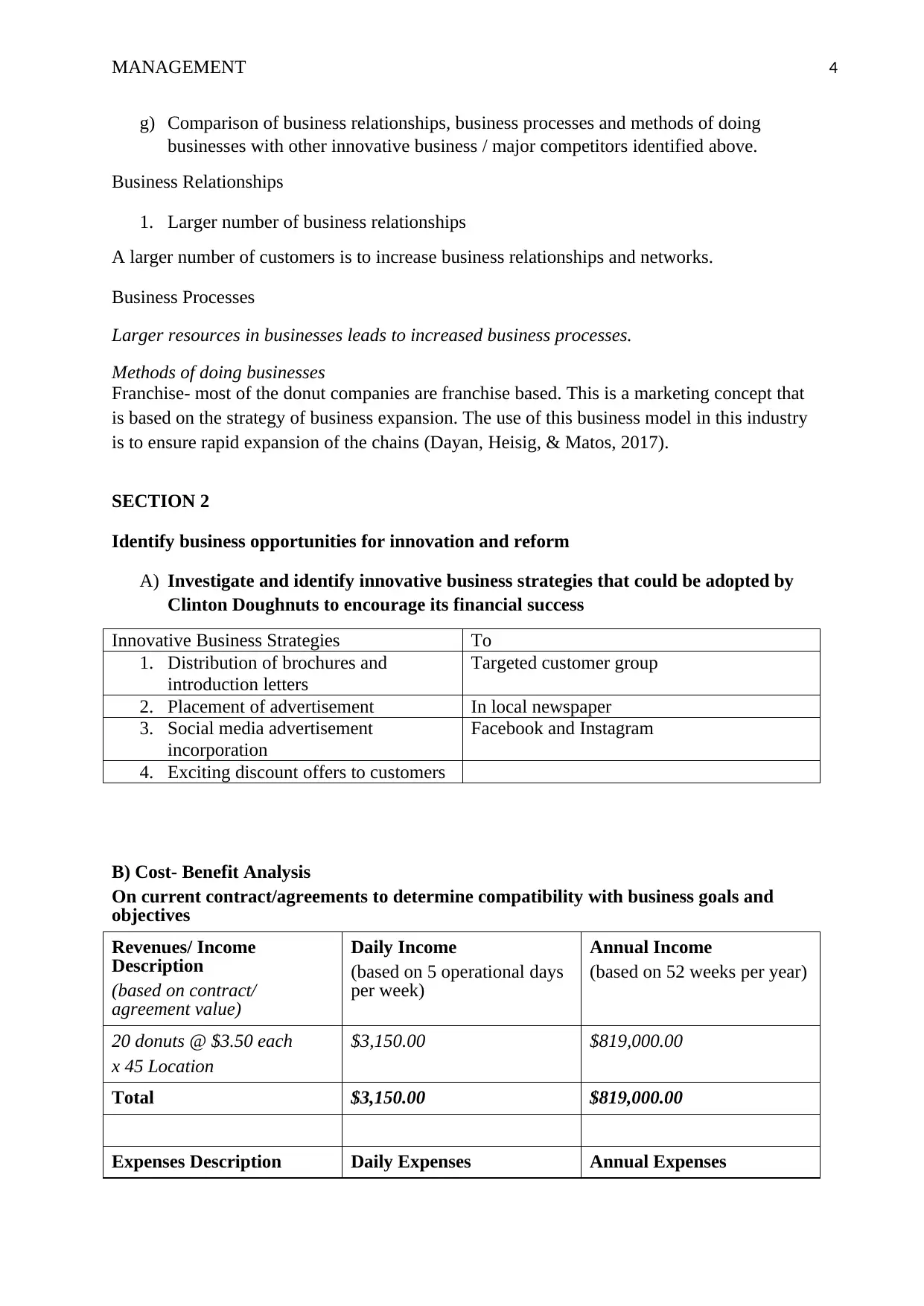
MANAGEMENT 4
g) Comparison of business relationships, business processes and methods of doing
businesses with other innovative business / major competitors identified above.
Business Relationships
1. Larger number of business relationships
A larger number of customers is to increase business relationships and networks.
Business Processes
Larger resources in businesses leads to increased business processes.
Methods of doing businesses
Franchise- most of the donut companies are franchise based. This is a marketing concept that
is based on the strategy of business expansion. The use of this business model in this industry
is to ensure rapid expansion of the chains (Dayan, Heisig, & Matos, 2017).
SECTION 2
Identify business opportunities for innovation and reform
A) Investigate and identify innovative business strategies that could be adopted by
Clinton Doughnuts to encourage its financial success
Innovative Business Strategies To
1. Distribution of brochures and
introduction letters
Targeted customer group
2. Placement of advertisement In local newspaper
3. Social media advertisement
incorporation
Facebook and Instagram
4. Exciting discount offers to customers
B) Cost- Benefit Analysis
On current contract/agreements to determine compatibility with business goals and
objectives
Revenues/ Income
Description
(based on contract/
agreement value)
Daily Income
(based on 5 operational days
per week)
Annual Income
(based on 52 weeks per year)
20 donuts @ $3.50 each
x 45 Location
$3,150.00 $819,000.00
Total $3,150.00 $819,000.00
Expenses Description Daily Expenses Annual Expenses
g) Comparison of business relationships, business processes and methods of doing
businesses with other innovative business / major competitors identified above.
Business Relationships
1. Larger number of business relationships
A larger number of customers is to increase business relationships and networks.
Business Processes
Larger resources in businesses leads to increased business processes.
Methods of doing businesses
Franchise- most of the donut companies are franchise based. This is a marketing concept that
is based on the strategy of business expansion. The use of this business model in this industry
is to ensure rapid expansion of the chains (Dayan, Heisig, & Matos, 2017).
SECTION 2
Identify business opportunities for innovation and reform
A) Investigate and identify innovative business strategies that could be adopted by
Clinton Doughnuts to encourage its financial success
Innovative Business Strategies To
1. Distribution of brochures and
introduction letters
Targeted customer group
2. Placement of advertisement In local newspaper
3. Social media advertisement
incorporation
Facebook and Instagram
4. Exciting discount offers to customers
B) Cost- Benefit Analysis
On current contract/agreements to determine compatibility with business goals and
objectives
Revenues/ Income
Description
(based on contract/
agreement value)
Daily Income
(based on 5 operational days
per week)
Annual Income
(based on 52 weeks per year)
20 donuts @ $3.50 each
x 45 Location
$3,150.00 $819,000.00
Total $3,150.00 $819,000.00
Expenses Description Daily Expenses Annual Expenses
Paraphrase This Document
Need a fresh take? Get an instant paraphrase of this document with our AI Paraphraser
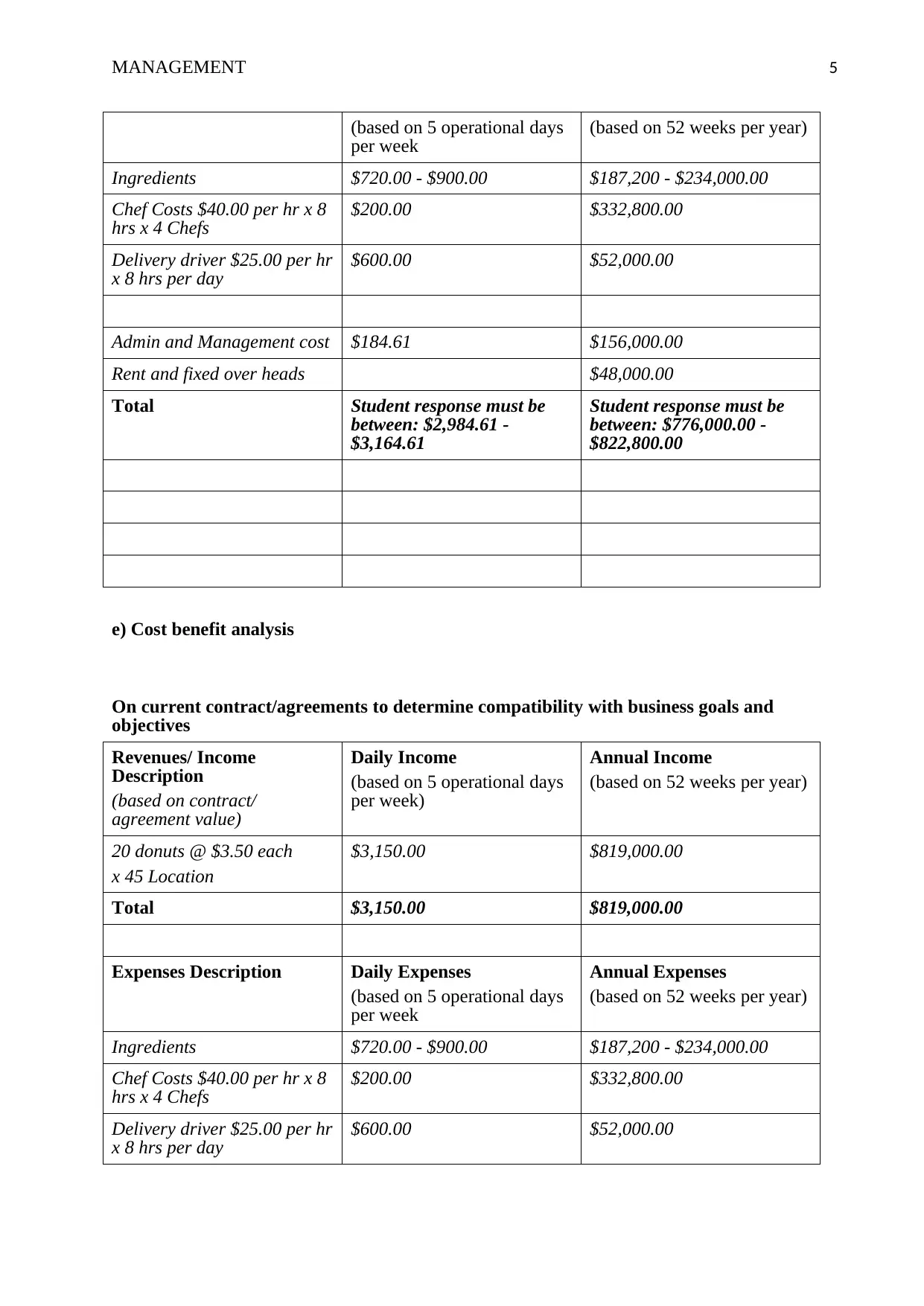
MANAGEMENT 5
(based on 5 operational days
per week (based on 52 weeks per year)
Ingredients $720.00 - $900.00 $187,200 - $234,000.00
Chef Costs $40.00 per hr x 8
hrs x 4 Chefs $200.00 $332,800.00
Delivery driver $25.00 per hr
x 8 hrs per day $600.00 $52,000.00
Admin and Management cost $184.61 $156,000.00
Rent and fixed over heads $48,000.00
Total Student response must be
between: $2,984.61 -
$3,164.61
Student response must be
between: $776,000.00 -
$822,800.00
e) Cost benefit analysis
On current contract/agreements to determine compatibility with business goals and
objectives
Revenues/ Income
Description
(based on contract/
agreement value)
Daily Income
(based on 5 operational days
per week)
Annual Income
(based on 52 weeks per year)
20 donuts @ $3.50 each
x 45 Location
$3,150.00 $819,000.00
Total $3,150.00 $819,000.00
Expenses Description Daily Expenses
(based on 5 operational days
per week
Annual Expenses
(based on 52 weeks per year)
Ingredients $720.00 - $900.00 $187,200 - $234,000.00
Chef Costs $40.00 per hr x 8
hrs x 4 Chefs $200.00 $332,800.00
Delivery driver $25.00 per hr
x 8 hrs per day $600.00 $52,000.00
(based on 5 operational days
per week (based on 52 weeks per year)
Ingredients $720.00 - $900.00 $187,200 - $234,000.00
Chef Costs $40.00 per hr x 8
hrs x 4 Chefs $200.00 $332,800.00
Delivery driver $25.00 per hr
x 8 hrs per day $600.00 $52,000.00
Admin and Management cost $184.61 $156,000.00
Rent and fixed over heads $48,000.00
Total Student response must be
between: $2,984.61 -
$3,164.61
Student response must be
between: $776,000.00 -
$822,800.00
e) Cost benefit analysis
On current contract/agreements to determine compatibility with business goals and
objectives
Revenues/ Income
Description
(based on contract/
agreement value)
Daily Income
(based on 5 operational days
per week)
Annual Income
(based on 52 weeks per year)
20 donuts @ $3.50 each
x 45 Location
$3,150.00 $819,000.00
Total $3,150.00 $819,000.00
Expenses Description Daily Expenses
(based on 5 operational days
per week
Annual Expenses
(based on 52 weeks per year)
Ingredients $720.00 - $900.00 $187,200 - $234,000.00
Chef Costs $40.00 per hr x 8
hrs x 4 Chefs $200.00 $332,800.00
Delivery driver $25.00 per hr
x 8 hrs per day $600.00 $52,000.00
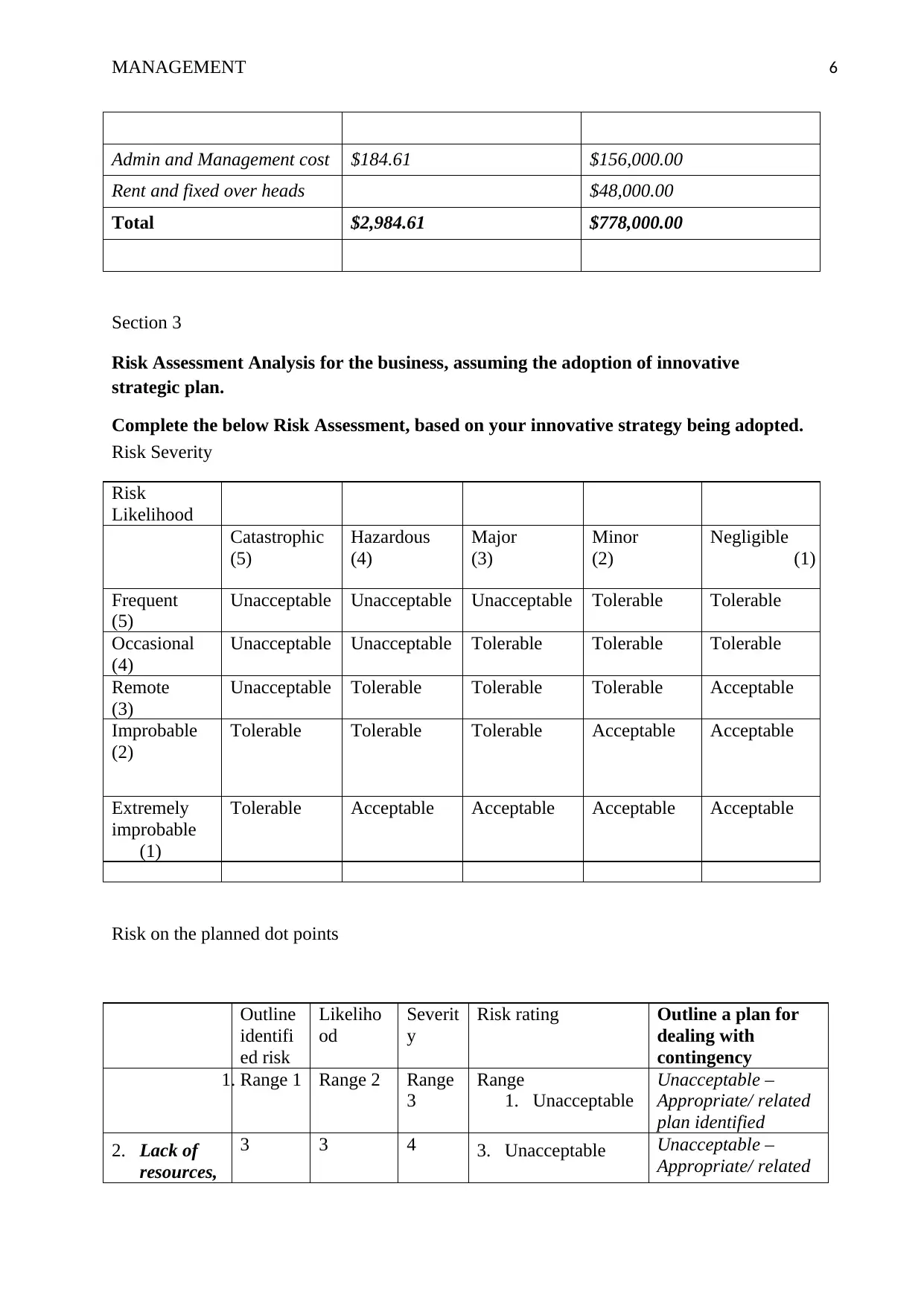
MANAGEMENT 6
Admin and Management cost $184.61 $156,000.00
Rent and fixed over heads $48,000.00
Total $2,984.61 $778,000.00
Section 3
Risk Assessment Analysis for the business, assuming the adoption of innovative
strategic plan.
Complete the below Risk Assessment, based on your innovative strategy being adopted.
Risk Severity
Risk
Likelihood
Catastrophic
(5)
Hazardous
(4)
Major
(3)
Minor
(2)
Negligible
(1)
Frequent
(5)
Unacceptable Unacceptable Unacceptable Tolerable Tolerable
Occasional
(4)
Unacceptable Unacceptable Tolerable Tolerable Tolerable
Remote
(3)
Unacceptable Tolerable Tolerable Tolerable Acceptable
Improbable
(2)
Tolerable Tolerable Tolerable Acceptable Acceptable
Extremely
improbable
(1)
Tolerable Acceptable Acceptable Acceptable Acceptable
Risk on the planned dot points
Outline
identifi
ed risk
Likeliho
od
Severit
y
Risk rating Outline a plan for
dealing with
contingency
1. Range 1 Range 2 Range
3
Range
1. Unacceptable
Unacceptable –
Appropriate/ related
plan identified
2. Lack of
resources,
3 3 4 3. Unacceptable Unacceptable –
Appropriate/ related
Admin and Management cost $184.61 $156,000.00
Rent and fixed over heads $48,000.00
Total $2,984.61 $778,000.00
Section 3
Risk Assessment Analysis for the business, assuming the adoption of innovative
strategic plan.
Complete the below Risk Assessment, based on your innovative strategy being adopted.
Risk Severity
Risk
Likelihood
Catastrophic
(5)
Hazardous
(4)
Major
(3)
Minor
(2)
Negligible
(1)
Frequent
(5)
Unacceptable Unacceptable Unacceptable Tolerable Tolerable
Occasional
(4)
Unacceptable Unacceptable Tolerable Tolerable Tolerable
Remote
(3)
Unacceptable Tolerable Tolerable Tolerable Acceptable
Improbable
(2)
Tolerable Tolerable Tolerable Acceptable Acceptable
Extremely
improbable
(1)
Tolerable Acceptable Acceptable Acceptable Acceptable
Risk on the planned dot points
Outline
identifi
ed risk
Likeliho
od
Severit
y
Risk rating Outline a plan for
dealing with
contingency
1. Range 1 Range 2 Range
3
Range
1. Unacceptable
Unacceptable –
Appropriate/ related
plan identified
2. Lack of
resources,
3 3 4 3. Unacceptable Unacceptable –
Appropriate/ related
⊘ This is a preview!⊘
Do you want full access?
Subscribe today to unlock all pages.

Trusted by 1+ million students worldwide
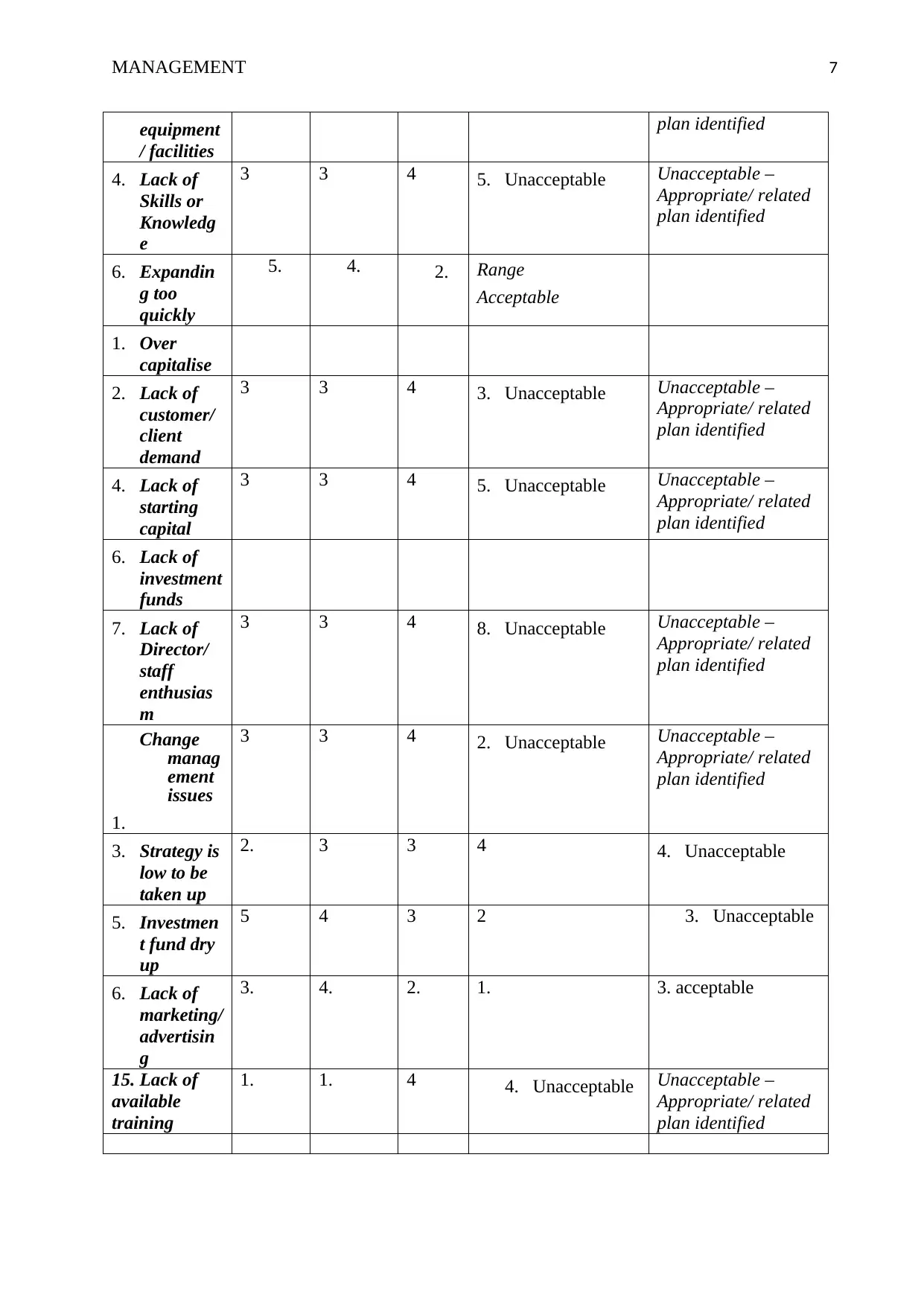
MANAGEMENT 7
equipment
/ facilities
plan identified
4. Lack of
Skills or
Knowledg
e
3 3 4 5. Unacceptable Unacceptable –
Appropriate/ related
plan identified
6. Expandin
g too
quickly
5. 4. 2. Range
Acceptable
1. Over
capitalise
2. Lack of
customer/
client
demand
3 3 4 3. Unacceptable Unacceptable –
Appropriate/ related
plan identified
4. Lack of
starting
capital
3 3 4 5. Unacceptable Unacceptable –
Appropriate/ related
plan identified
6. Lack of
investment
funds
7. Lack of
Director/
staff
enthusias
m
3 3 4 8. Unacceptable Unacceptable –
Appropriate/ related
plan identified
Change
manag
ement
issues
1.
3 3 4 2. Unacceptable Unacceptable –
Appropriate/ related
plan identified
3. Strategy is
low to be
taken up
2. 3 3 4 4. Unacceptable
5. Investmen
t fund dry
up
5 4 3 2 3. Unacceptable
6. Lack of
marketing/
advertisin
g
3. 4. 2. 1. 3. acceptable
15. Lack of
available
training
1. 1. 4 4. Unacceptable Unacceptable –
Appropriate/ related
plan identified
equipment
/ facilities
plan identified
4. Lack of
Skills or
Knowledg
e
3 3 4 5. Unacceptable Unacceptable –
Appropriate/ related
plan identified
6. Expandin
g too
quickly
5. 4. 2. Range
Acceptable
1. Over
capitalise
2. Lack of
customer/
client
demand
3 3 4 3. Unacceptable Unacceptable –
Appropriate/ related
plan identified
4. Lack of
starting
capital
3 3 4 5. Unacceptable Unacceptable –
Appropriate/ related
plan identified
6. Lack of
investment
funds
7. Lack of
Director/
staff
enthusias
m
3 3 4 8. Unacceptable Unacceptable –
Appropriate/ related
plan identified
Change
manag
ement
issues
1.
3 3 4 2. Unacceptable Unacceptable –
Appropriate/ related
plan identified
3. Strategy is
low to be
taken up
2. 3 3 4 4. Unacceptable
5. Investmen
t fund dry
up
5 4 3 2 3. Unacceptable
6. Lack of
marketing/
advertisin
g
3. 4. 2. 1. 3. acceptable
15. Lack of
available
training
1. 1. 4 4. Unacceptable Unacceptable –
Appropriate/ related
plan identified
Paraphrase This Document
Need a fresh take? Get an instant paraphrase of this document with our AI Paraphraser
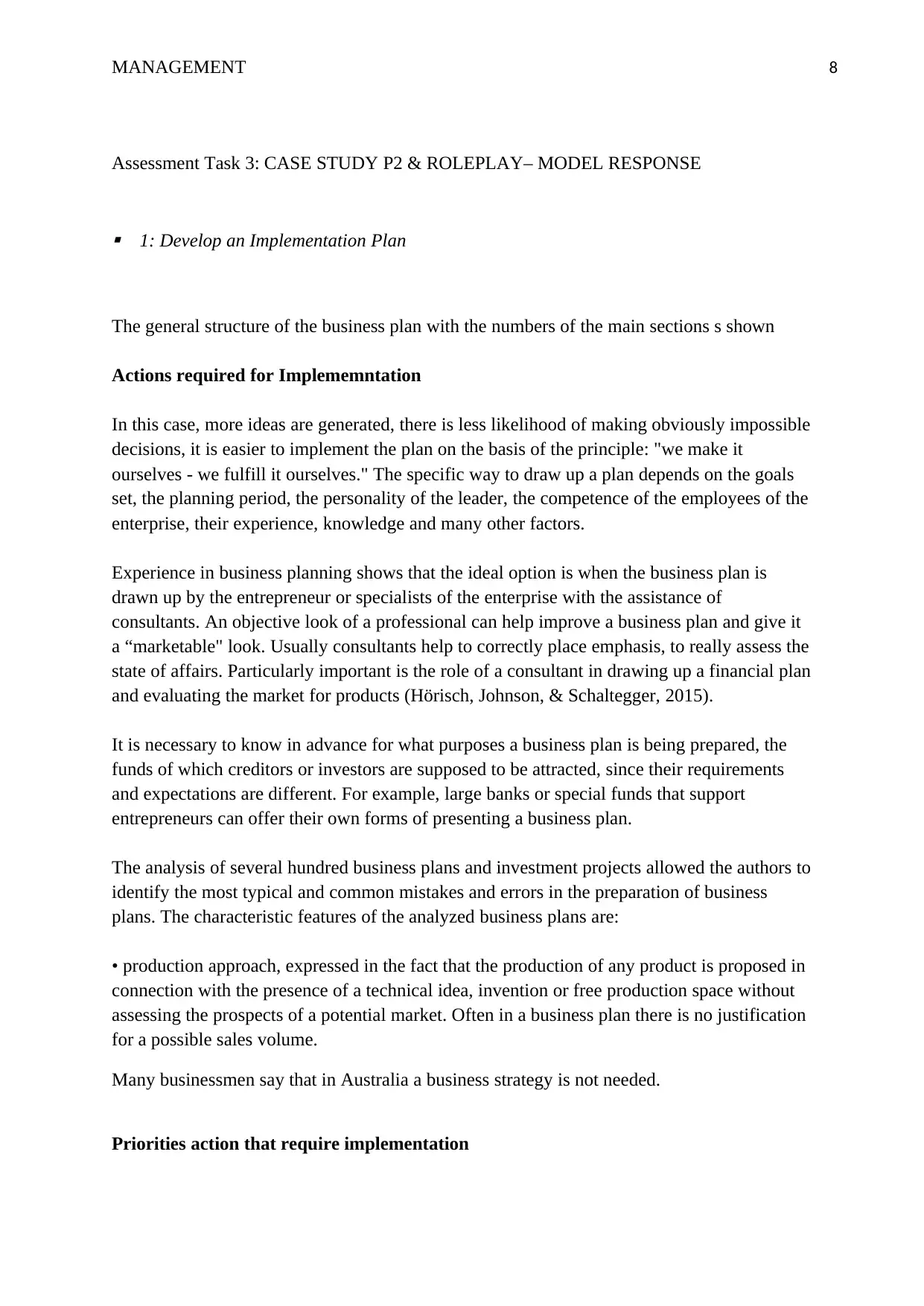
MANAGEMENT 8
Assessment Task 3: CASE STUDY P2 & ROLEPLAY– MODEL RESPONSE
1: Develop an Implementation Plan
The general structure of the business plan with the numbers of the main sections s shown
Actions required for Implememntation
In this case, more ideas are generated, there is less likelihood of making obviously impossible
decisions, it is easier to implement the plan on the basis of the principle: "we make it
ourselves - we fulfill it ourselves." The specific way to draw up a plan depends on the goals
set, the planning period, the personality of the leader, the competence of the employees of the
enterprise, their experience, knowledge and many other factors.
Experience in business planning shows that the ideal option is when the business plan is
drawn up by the entrepreneur or specialists of the enterprise with the assistance of
consultants. An objective look of a professional can help improve a business plan and give it
a “marketable" look. Usually consultants help to correctly place emphasis, to really assess the
state of affairs. Particularly important is the role of a consultant in drawing up a financial plan
and evaluating the market for products (Hörisch, Johnson, & Schaltegger, 2015).
It is necessary to know in advance for what purposes a business plan is being prepared, the
funds of which creditors or investors are supposed to be attracted, since their requirements
and expectations are different. For example, large banks or special funds that support
entrepreneurs can offer their own forms of presenting a business plan.
The analysis of several hundred business plans and investment projects allowed the authors to
identify the most typical and common mistakes and errors in the preparation of business
plans. The characteristic features of the analyzed business plans are:
• production approach, expressed in the fact that the production of any product is proposed in
connection with the presence of a technical idea, invention or free production space without
assessing the prospects of a potential market. Often in a business plan there is no justification
for a possible sales volume.
Many businessmen say that in Australia a business strategy is not needed.
Priorities action that require implementation
Assessment Task 3: CASE STUDY P2 & ROLEPLAY– MODEL RESPONSE
1: Develop an Implementation Plan
The general structure of the business plan with the numbers of the main sections s shown
Actions required for Implememntation
In this case, more ideas are generated, there is less likelihood of making obviously impossible
decisions, it is easier to implement the plan on the basis of the principle: "we make it
ourselves - we fulfill it ourselves." The specific way to draw up a plan depends on the goals
set, the planning period, the personality of the leader, the competence of the employees of the
enterprise, their experience, knowledge and many other factors.
Experience in business planning shows that the ideal option is when the business plan is
drawn up by the entrepreneur or specialists of the enterprise with the assistance of
consultants. An objective look of a professional can help improve a business plan and give it
a “marketable" look. Usually consultants help to correctly place emphasis, to really assess the
state of affairs. Particularly important is the role of a consultant in drawing up a financial plan
and evaluating the market for products (Hörisch, Johnson, & Schaltegger, 2015).
It is necessary to know in advance for what purposes a business plan is being prepared, the
funds of which creditors or investors are supposed to be attracted, since their requirements
and expectations are different. For example, large banks or special funds that support
entrepreneurs can offer their own forms of presenting a business plan.
The analysis of several hundred business plans and investment projects allowed the authors to
identify the most typical and common mistakes and errors in the preparation of business
plans. The characteristic features of the analyzed business plans are:
• production approach, expressed in the fact that the production of any product is proposed in
connection with the presence of a technical idea, invention or free production space without
assessing the prospects of a potential market. Often in a business plan there is no justification
for a possible sales volume.
Many businessmen say that in Australia a business strategy is not needed.
Priorities action that require implementation
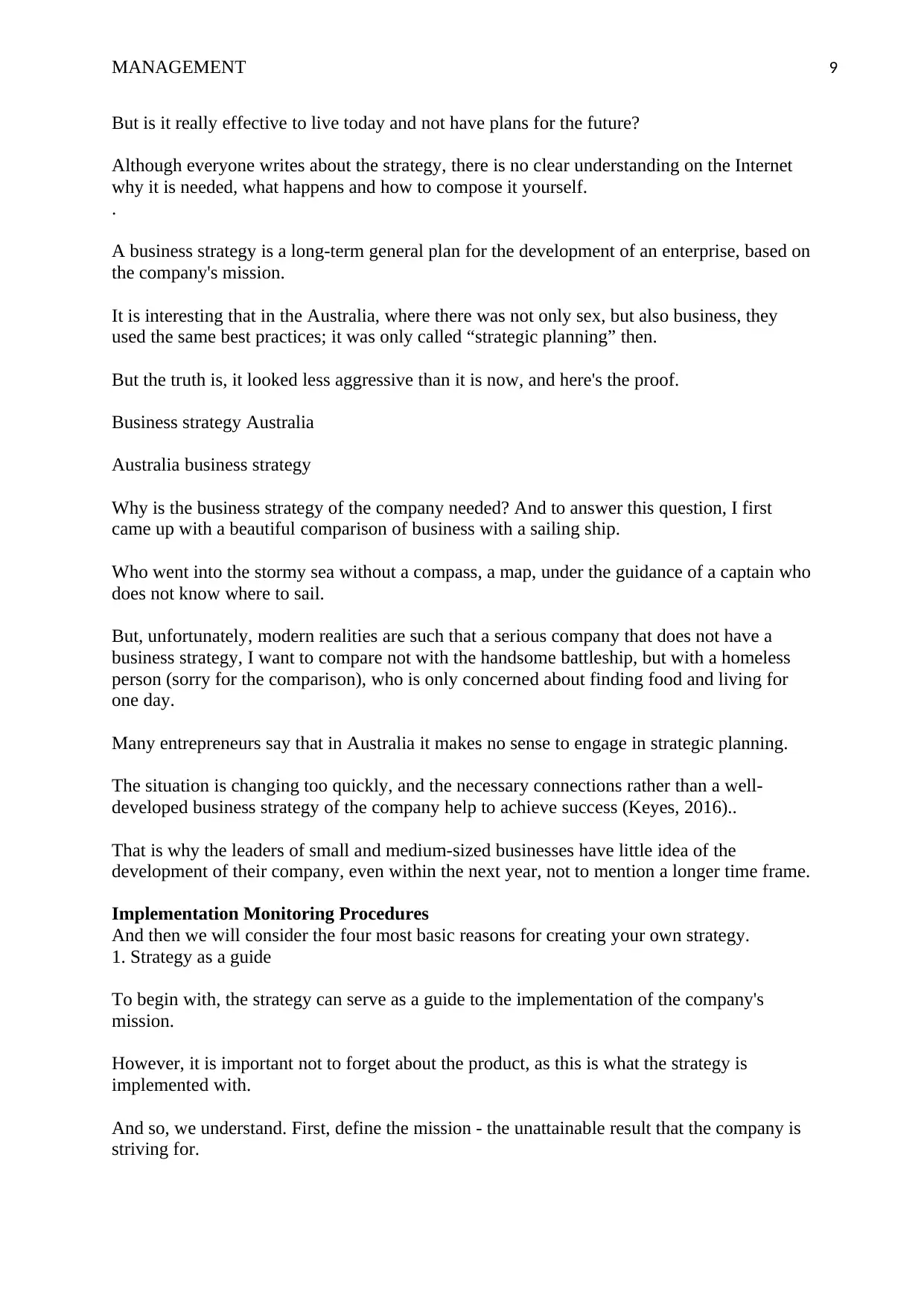
MANAGEMENT 9
But is it really effective to live today and not have plans for the future?
Although everyone writes about the strategy, there is no clear understanding on the Internet
why it is needed, what happens and how to compose it yourself.
.
A business strategy is a long-term general plan for the development of an enterprise, based on
the company's mission.
It is interesting that in the Australia, where there was not only sex, but also business, they
used the same best practices; it was only called “strategic planning” then.
But the truth is, it looked less aggressive than it is now, and here's the proof.
Business strategy Australia
Australia business strategy
Why is the business strategy of the company needed? And to answer this question, I first
came up with a beautiful comparison of business with a sailing ship.
Who went into the stormy sea without a compass, a map, under the guidance of a captain who
does not know where to sail.
But, unfortunately, modern realities are such that a serious company that does not have a
business strategy, I want to compare not with the handsome battleship, but with a homeless
person (sorry for the comparison), who is only concerned about finding food and living for
one day.
Many entrepreneurs say that in Australia it makes no sense to engage in strategic planning.
The situation is changing too quickly, and the necessary connections rather than a well-
developed business strategy of the company help to achieve success (Keyes, 2016)..
That is why the leaders of small and medium-sized businesses have little idea of the
development of their company, even within the next year, not to mention a longer time frame.
Implementation Monitoring Procedures
And then we will consider the four most basic reasons for creating your own strategy.
1. Strategy as a guide
To begin with, the strategy can serve as a guide to the implementation of the company's
mission.
However, it is important not to forget about the product, as this is what the strategy is
implemented with.
And so, we understand. First, define the mission - the unattainable result that the company is
striving for.
But is it really effective to live today and not have plans for the future?
Although everyone writes about the strategy, there is no clear understanding on the Internet
why it is needed, what happens and how to compose it yourself.
.
A business strategy is a long-term general plan for the development of an enterprise, based on
the company's mission.
It is interesting that in the Australia, where there was not only sex, but also business, they
used the same best practices; it was only called “strategic planning” then.
But the truth is, it looked less aggressive than it is now, and here's the proof.
Business strategy Australia
Australia business strategy
Why is the business strategy of the company needed? And to answer this question, I first
came up with a beautiful comparison of business with a sailing ship.
Who went into the stormy sea without a compass, a map, under the guidance of a captain who
does not know where to sail.
But, unfortunately, modern realities are such that a serious company that does not have a
business strategy, I want to compare not with the handsome battleship, but with a homeless
person (sorry for the comparison), who is only concerned about finding food and living for
one day.
Many entrepreneurs say that in Australia it makes no sense to engage in strategic planning.
The situation is changing too quickly, and the necessary connections rather than a well-
developed business strategy of the company help to achieve success (Keyes, 2016)..
That is why the leaders of small and medium-sized businesses have little idea of the
development of their company, even within the next year, not to mention a longer time frame.
Implementation Monitoring Procedures
And then we will consider the four most basic reasons for creating your own strategy.
1. Strategy as a guide
To begin with, the strategy can serve as a guide to the implementation of the company's
mission.
However, it is important not to forget about the product, as this is what the strategy is
implemented with.
And so, we understand. First, define the mission - the unattainable result that the company is
striving for.
⊘ This is a preview!⊘
Do you want full access?
Subscribe today to unlock all pages.

Trusted by 1+ million students worldwide
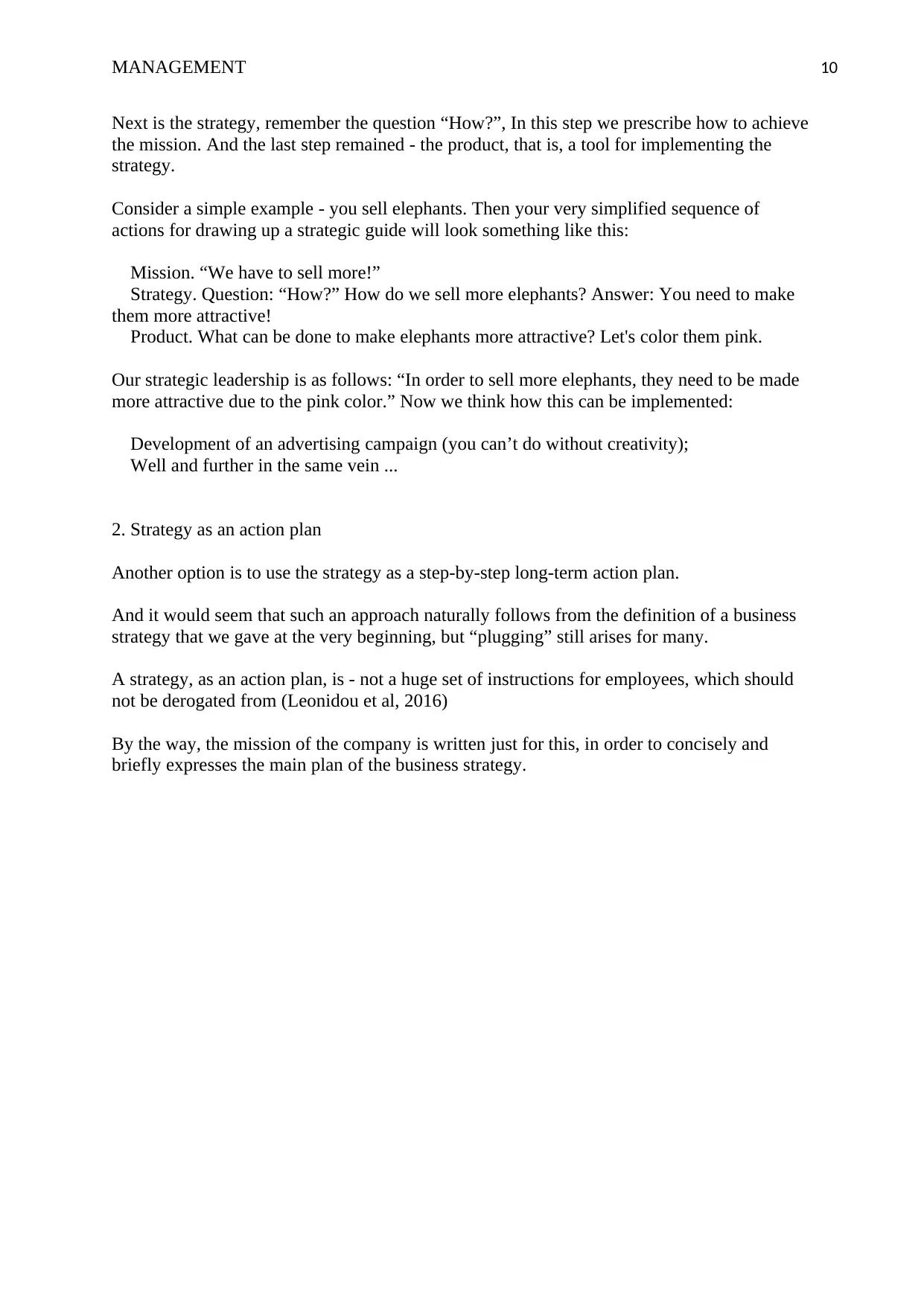
MANAGEMENT 10
Next is the strategy, remember the question “How?”, In this step we prescribe how to achieve
the mission. And the last step remained - the product, that is, a tool for implementing the
strategy.
Consider a simple example - you sell elephants. Then your very simplified sequence of
actions for drawing up a strategic guide will look something like this:
Mission. “We have to sell more!”
Strategy. Question: “How?” How do we sell more elephants? Answer: You need to make
them more attractive!
Product. What can be done to make elephants more attractive? Let's color them pink.
Our strategic leadership is as follows: “In order to sell more elephants, they need to be made
more attractive due to the pink color.” Now we think how this can be implemented:
Development of an advertising campaign (you can’t do without creativity);
Well and further in the same vein ...
2. Strategy as an action plan
Another option is to use the strategy as a step-by-step long-term action plan.
And it would seem that such an approach naturally follows from the definition of a business
strategy that we gave at the very beginning, but “plugging” still arises for many.
A strategy, as an action plan, is - not a huge set of instructions for employees, which should
not be derogated from (Leonidou et al, 2016)
By the way, the mission of the company is written just for this, in order to concisely and
briefly expresses the main plan of the business strategy.
Next is the strategy, remember the question “How?”, In this step we prescribe how to achieve
the mission. And the last step remained - the product, that is, a tool for implementing the
strategy.
Consider a simple example - you sell elephants. Then your very simplified sequence of
actions for drawing up a strategic guide will look something like this:
Mission. “We have to sell more!”
Strategy. Question: “How?” How do we sell more elephants? Answer: You need to make
them more attractive!
Product. What can be done to make elephants more attractive? Let's color them pink.
Our strategic leadership is as follows: “In order to sell more elephants, they need to be made
more attractive due to the pink color.” Now we think how this can be implemented:
Development of an advertising campaign (you can’t do without creativity);
Well and further in the same vein ...
2. Strategy as an action plan
Another option is to use the strategy as a step-by-step long-term action plan.
And it would seem that such an approach naturally follows from the definition of a business
strategy that we gave at the very beginning, but “plugging” still arises for many.
A strategy, as an action plan, is - not a huge set of instructions for employees, which should
not be derogated from (Leonidou et al, 2016)
By the way, the mission of the company is written just for this, in order to concisely and
briefly expresses the main plan of the business strategy.
Paraphrase This Document
Need a fresh take? Get an instant paraphrase of this document with our AI Paraphraser
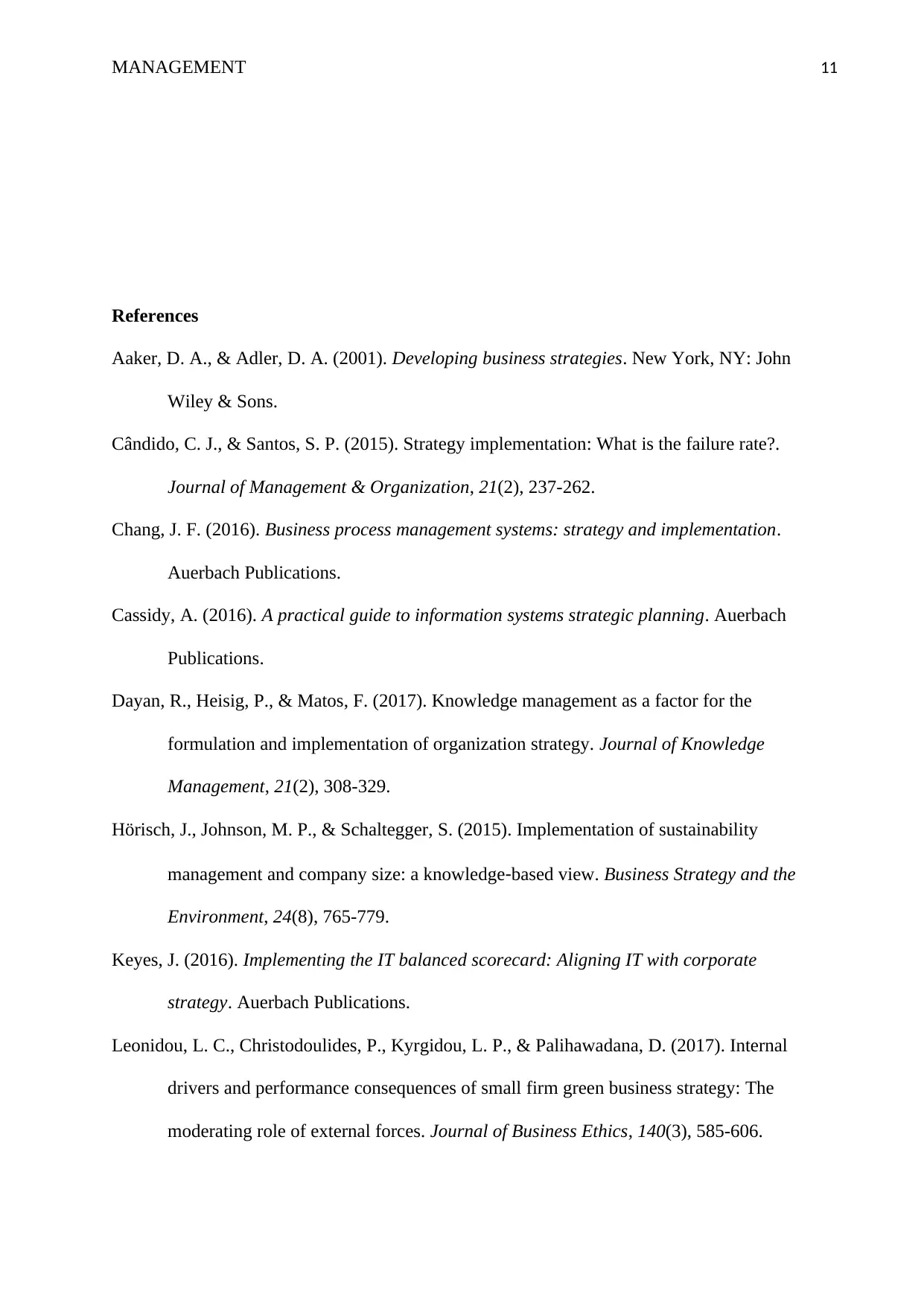
MANAGEMENT 11
References
Aaker, D. A., & Adler, D. A. (2001). Developing business strategies. New York, NY: John
Wiley & Sons.
Cândido, C. J., & Santos, S. P. (2015). Strategy implementation: What is the failure rate?.
Journal of Management & Organization, 21(2), 237-262.
Chang, J. F. (2016). Business process management systems: strategy and implementation.
Auerbach Publications.
Cassidy, A. (2016). A practical guide to information systems strategic planning. Auerbach
Publications.
Dayan, R., Heisig, P., & Matos, F. (2017). Knowledge management as a factor for the
formulation and implementation of organization strategy. Journal of Knowledge
Management, 21(2), 308-329.
Hörisch, J., Johnson, M. P., & Schaltegger, S. (2015). Implementation of sustainability
management and company size: a knowledge‐based view. Business Strategy and the
Environment, 24(8), 765-779.
Keyes, J. (2016). Implementing the IT balanced scorecard: Aligning IT with corporate
strategy. Auerbach Publications.
Leonidou, L. C., Christodoulides, P., Kyrgidou, L. P., & Palihawadana, D. (2017). Internal
drivers and performance consequences of small firm green business strategy: The
moderating role of external forces. Journal of Business Ethics, 140(3), 585-606.
References
Aaker, D. A., & Adler, D. A. (2001). Developing business strategies. New York, NY: John
Wiley & Sons.
Cândido, C. J., & Santos, S. P. (2015). Strategy implementation: What is the failure rate?.
Journal of Management & Organization, 21(2), 237-262.
Chang, J. F. (2016). Business process management systems: strategy and implementation.
Auerbach Publications.
Cassidy, A. (2016). A practical guide to information systems strategic planning. Auerbach
Publications.
Dayan, R., Heisig, P., & Matos, F. (2017). Knowledge management as a factor for the
formulation and implementation of organization strategy. Journal of Knowledge
Management, 21(2), 308-329.
Hörisch, J., Johnson, M. P., & Schaltegger, S. (2015). Implementation of sustainability
management and company size: a knowledge‐based view. Business Strategy and the
Environment, 24(8), 765-779.
Keyes, J. (2016). Implementing the IT balanced scorecard: Aligning IT with corporate
strategy. Auerbach Publications.
Leonidou, L. C., Christodoulides, P., Kyrgidou, L. P., & Palihawadana, D. (2017). Internal
drivers and performance consequences of small firm green business strategy: The
moderating role of external forces. Journal of Business Ethics, 140(3), 585-606.

MANAGEMENT 12
⊘ This is a preview!⊘
Do you want full access?
Subscribe today to unlock all pages.

Trusted by 1+ million students worldwide
1 out of 12
Your All-in-One AI-Powered Toolkit for Academic Success.
+13062052269
info@desklib.com
Available 24*7 on WhatsApp / Email
![[object Object]](/_next/static/media/star-bottom.7253800d.svg)
Unlock your academic potential
Copyright © 2020–2025 A2Z Services. All Rights Reserved. Developed and managed by ZUCOL.

